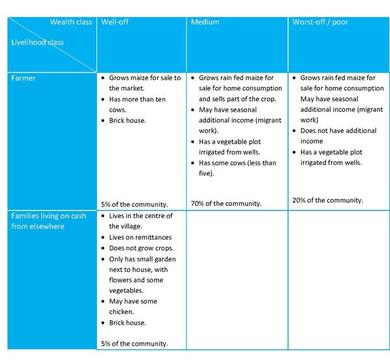Tool 3
TOOL 3. WATER USER CATEGORISATION: LIVELIHOOD GROUPS AND WEALTH RANKING
To identify the main categories of users in the community, their wealth status and their main livelihoods strategies, and to identify the role of water in these strategies.
OBJECTIVE
To identify the main categories of users in the community, their wealth status and their main livelihoods strategies, and to identify the role of water in these strategies.
METHOD
This exercise can be done as a focus group discussion (see Tool 2). The focus group then needs to be a good representation of the case study site (people from different communities, men/women, irrigators, livestock holders, well-off / poor), with people from different areas within the case study site.
Step 1: Identification of livelihood groups
- Ask the group ‘which livelihoods strategies do people employ in the community?’
- While the community members answer, the facilitator writes these categories on a flip chart. Typical categories can include small former (those that only produce for home consumption) and larger farmers (those that produce for the market), cattle owners, people living off cash from elsewhere (pensioners, people living of remittances), employees, etc.
Step 2: Identification of wealth categories
- Have the group make drawings of a well-off / wealthy person, a worst-off / poor person and someone in between, on A4 paper and ask them to describe six to seven characteristics of each person.
Step 3: The characteristics of the water users
- Discuss links between the livelihood groups and wealth groups and come to a classification of water user groups. Community members are asked to provide a further characterisation of each group by going through the following questions:
- For each of the categories, what are the key characteristics defining their social and economic conditions, in terms of, for example, housing conditions, land ownership or access to cash? What local criteria exist to differentiate between them?
- For each of the categories, what are their characteristics in terms of access to and use of water? Which sources do they use, and for what purpose?
- For each of the categories, what would be their future water needs? And what is their own capacity to contribute to developing those?
- The facilitator writes these characteristics under each user category, coming to a final matrix. An example of such a matrix is given below.
Step 4: Distribution of water-users groups in the community
- In order to get an idea of the distribution of water-user groups within the community, the group can be asked to place cards with the household names or numbers under the different categories.
- Alternative: If it is too sensitive to classify the households under the different categories, the facilitator can collect 100 small stones, seeds or berries. The group can be asked to distribute the stones, seeds or berries under the different categories, thus expressing the percentage of user categories.
Table 4 - Example of water user characterisation matrix

Source: ZIMWASH, 2010 and Smits and Mejía, 2011
TIPS AND TRICKS
- The facilitator should not present the user classification matrix upfront, but should let the community identify the categories.
BASED ON
Tool 3 in: ZIMWASH, 2010. Guidelines for Planning for Water for Livelihoods, Harare: ZIMWASH Project.
Tool 2 in: Smits, S. and Mejía, T., 2011. Guía para la Planificación e Implementación de Proyectos de Usos Múltiples del Agua, The Hague / Tegucigalpa: IRC/ RASHON.
Tool 9 in: Bolt, E. and Fonseca, C., 2001. Keep it working: a field manual to support community management of rural water supplies,Technical paper series, IRC; no. 36, Delft: IRC International Water and Sanitation Centre.
